Health Sociology Assignment Solution Paper 2022
VerifiedAdded on 2022/10/01
|14
|7253
|27
Assignment
AI Summary
Contribute Materials
Your contribution can guide someone’s learning journey. Share your
documents today.
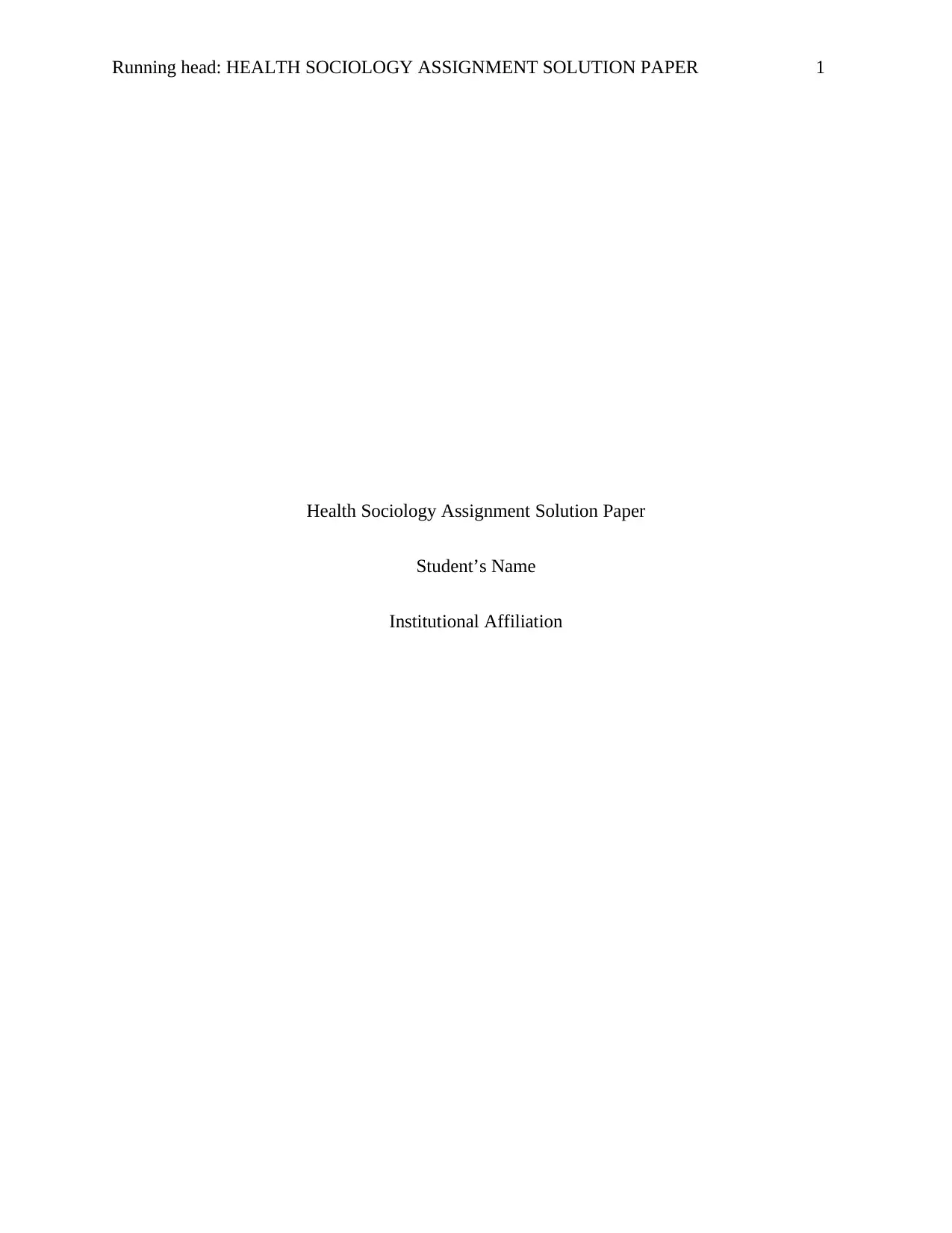
Running head: HEALTH SOCIOLOGY ASSIGNMENT SOLUTION PAPER 1
Health Sociology Assignment Solution Paper
Student’s Name
Institutional Affiliation
Health Sociology Assignment Solution Paper
Student’s Name
Institutional Affiliation
Secure Best Marks with AI Grader
Need help grading? Try our AI Grader for instant feedback on your assignments.
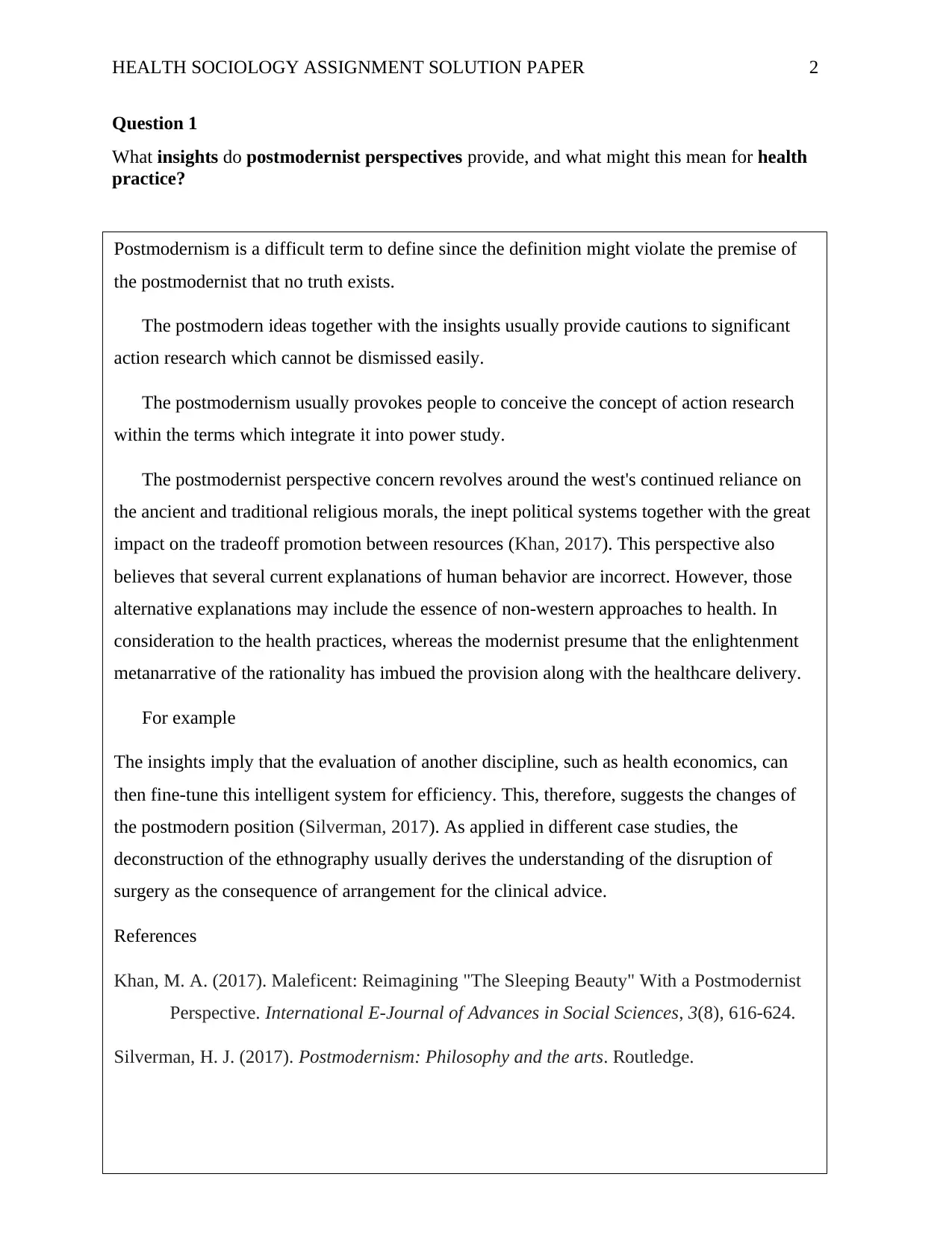
HEALTH SOCIOLOGY ASSIGNMENT SOLUTION PAPER 2
Question 1
What insights do postmodernist perspectives provide, and what might this mean for health
practice?
Postmodernism is a difficult term to define since the definition might violate the premise of
the postmodernist that no truth exists.
The postmodern ideas together with the insights usually provide cautions to significant
action research which cannot be dismissed easily.
The postmodernism usually provokes people to conceive the concept of action research
within the terms which integrate it into power study.
The postmodernist perspective concern revolves around the west's continued reliance on
the ancient and traditional religious morals, the inept political systems together with the great
impact on the tradeoff promotion between resources (Khan, 2017). This perspective also
believes that several current explanations of human behavior are incorrect. However, those
alternative explanations may include the essence of non-western approaches to health. In
consideration to the health practices, whereas the modernist presume that the enlightenment
metanarrative of the rationality has imbued the provision along with the healthcare delivery.
For example
The insights imply that the evaluation of another discipline, such as health economics, can
then fine-tune this intelligent system for efficiency. This, therefore, suggests the changes of
the postmodern position (Silverman, 2017). As applied in different case studies, the
deconstruction of the ethnography usually derives the understanding of the disruption of
surgery as the consequence of arrangement for the clinical advice.
References
Khan, M. A. (2017). Maleficent: Reimagining "The Sleeping Beauty" With a Postmodernist
Perspective. International E-Journal of Advances in Social Sciences, 3(8), 616-624.
Silverman, H. J. (2017). Postmodernism: Philosophy and the arts. Routledge.
Question 1
What insights do postmodernist perspectives provide, and what might this mean for health
practice?
Postmodernism is a difficult term to define since the definition might violate the premise of
the postmodernist that no truth exists.
The postmodern ideas together with the insights usually provide cautions to significant
action research which cannot be dismissed easily.
The postmodernism usually provokes people to conceive the concept of action research
within the terms which integrate it into power study.
The postmodernist perspective concern revolves around the west's continued reliance on
the ancient and traditional religious morals, the inept political systems together with the great
impact on the tradeoff promotion between resources (Khan, 2017). This perspective also
believes that several current explanations of human behavior are incorrect. However, those
alternative explanations may include the essence of non-western approaches to health. In
consideration to the health practices, whereas the modernist presume that the enlightenment
metanarrative of the rationality has imbued the provision along with the healthcare delivery.
For example
The insights imply that the evaluation of another discipline, such as health economics, can
then fine-tune this intelligent system for efficiency. This, therefore, suggests the changes of
the postmodern position (Silverman, 2017). As applied in different case studies, the
deconstruction of the ethnography usually derives the understanding of the disruption of
surgery as the consequence of arrangement for the clinical advice.
References
Khan, M. A. (2017). Maleficent: Reimagining "The Sleeping Beauty" With a Postmodernist
Perspective. International E-Journal of Advances in Social Sciences, 3(8), 616-624.
Silverman, H. J. (2017). Postmodernism: Philosophy and the arts. Routledge.
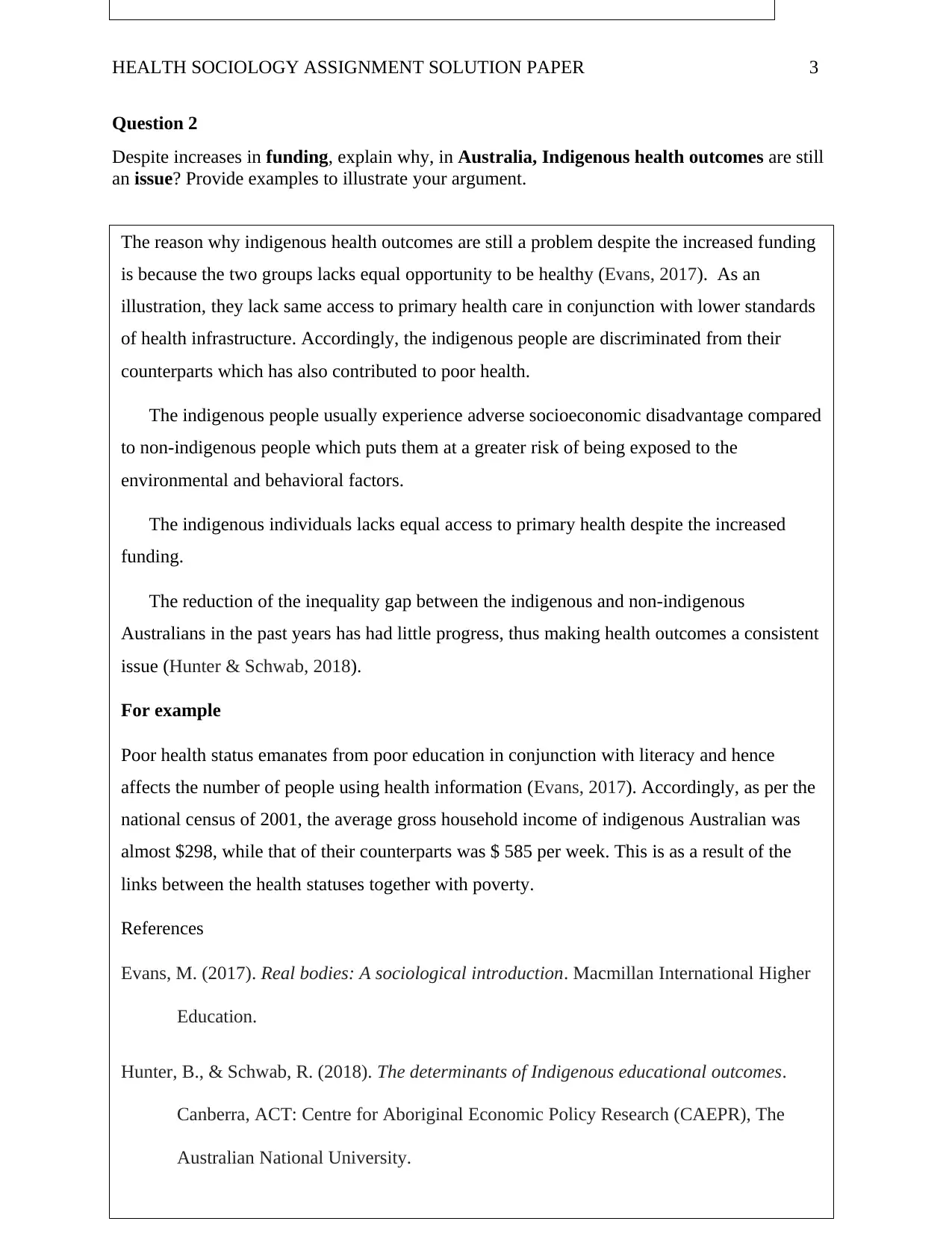
HEALTH SOCIOLOGY ASSIGNMENT SOLUTION PAPER 3
Question 2
Despite increases in funding, explain why, in Australia, Indigenous health outcomes are still
an issue? Provide examples to illustrate your argument.
The reason why indigenous health outcomes are still a problem despite the increased funding
is because the two groups lacks equal opportunity to be healthy (Evans, 2017). As an
illustration, they lack same access to primary health care in conjunction with lower standards
of health infrastructure. Accordingly, the indigenous people are discriminated from their
counterparts which has also contributed to poor health.
The indigenous people usually experience adverse socioeconomic disadvantage compared
to non-indigenous people which puts them at a greater risk of being exposed to the
environmental and behavioral factors.
The indigenous individuals lacks equal access to primary health despite the increased
funding.
The reduction of the inequality gap between the indigenous and non-indigenous
Australians in the past years has had little progress, thus making health outcomes a consistent
issue (Hunter & Schwab, 2018).
For example
Poor health status emanates from poor education in conjunction with literacy and hence
affects the number of people using health information (Evans, 2017). Accordingly, as per the
national census of 2001, the average gross household income of indigenous Australian was
almost $298, while that of their counterparts was $ 585 per week. This is as a result of the
links between the health statuses together with poverty.
References
Evans, M. (2017). Real bodies: A sociological introduction. Macmillan International Higher
Education.
Hunter, B., & Schwab, R. (2018). The determinants of Indigenous educational outcomes.
Canberra, ACT: Centre for Aboriginal Economic Policy Research (CAEPR), The
Australian National University.
Question 2
Despite increases in funding, explain why, in Australia, Indigenous health outcomes are still
an issue? Provide examples to illustrate your argument.
The reason why indigenous health outcomes are still a problem despite the increased funding
is because the two groups lacks equal opportunity to be healthy (Evans, 2017). As an
illustration, they lack same access to primary health care in conjunction with lower standards
of health infrastructure. Accordingly, the indigenous people are discriminated from their
counterparts which has also contributed to poor health.
The indigenous people usually experience adverse socioeconomic disadvantage compared
to non-indigenous people which puts them at a greater risk of being exposed to the
environmental and behavioral factors.
The indigenous individuals lacks equal access to primary health despite the increased
funding.
The reduction of the inequality gap between the indigenous and non-indigenous
Australians in the past years has had little progress, thus making health outcomes a consistent
issue (Hunter & Schwab, 2018).
For example
Poor health status emanates from poor education in conjunction with literacy and hence
affects the number of people using health information (Evans, 2017). Accordingly, as per the
national census of 2001, the average gross household income of indigenous Australian was
almost $298, while that of their counterparts was $ 585 per week. This is as a result of the
links between the health statuses together with poverty.
References
Evans, M. (2017). Real bodies: A sociological introduction. Macmillan International Higher
Education.
Hunter, B., & Schwab, R. (2018). The determinants of Indigenous educational outcomes.
Canberra, ACT: Centre for Aboriginal Economic Policy Research (CAEPR), The
Australian National University.
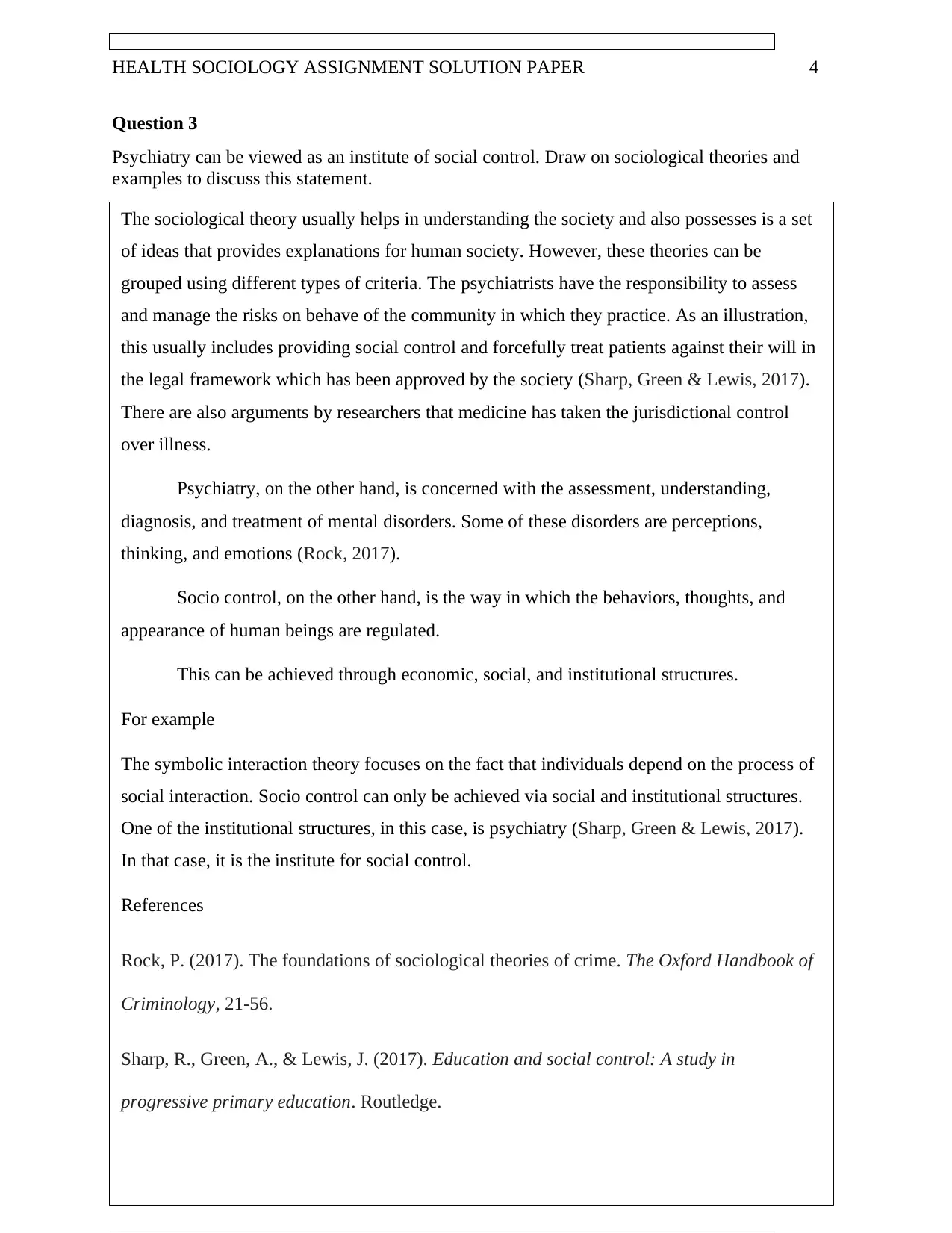
HEALTH SOCIOLOGY ASSIGNMENT SOLUTION PAPER 4
Question 3
Psychiatry can be viewed as an institute of social control. Draw on sociological theories and
examples to discuss this statement.
The sociological theory usually helps in understanding the society and also possesses is a set
of ideas that provides explanations for human society. However, these theories can be
grouped using different types of criteria. The psychiatrists have the responsibility to assess
and manage the risks on behave of the community in which they practice. As an illustration,
this usually includes providing social control and forcefully treat patients against their will in
the legal framework which has been approved by the society (Sharp, Green & Lewis, 2017).
There are also arguments by researchers that medicine has taken the jurisdictional control
over illness.
Psychiatry, on the other hand, is concerned with the assessment, understanding,
diagnosis, and treatment of mental disorders. Some of these disorders are perceptions,
thinking, and emotions (Rock, 2017).
Socio control, on the other hand, is the way in which the behaviors, thoughts, and
appearance of human beings are regulated.
This can be achieved through economic, social, and institutional structures.
For example
The symbolic interaction theory focuses on the fact that individuals depend on the process of
social interaction. Socio control can only be achieved via social and institutional structures.
One of the institutional structures, in this case, is psychiatry (Sharp, Green & Lewis, 2017).
In that case, it is the institute for social control.
References
Rock, P. (2017). The foundations of sociological theories of crime. The Oxford Handbook of
Criminology, 21-56.
Sharp, R., Green, A., & Lewis, J. (2017). Education and social control: A study in
progressive primary education. Routledge.
Question 3
Psychiatry can be viewed as an institute of social control. Draw on sociological theories and
examples to discuss this statement.
The sociological theory usually helps in understanding the society and also possesses is a set
of ideas that provides explanations for human society. However, these theories can be
grouped using different types of criteria. The psychiatrists have the responsibility to assess
and manage the risks on behave of the community in which they practice. As an illustration,
this usually includes providing social control and forcefully treat patients against their will in
the legal framework which has been approved by the society (Sharp, Green & Lewis, 2017).
There are also arguments by researchers that medicine has taken the jurisdictional control
over illness.
Psychiatry, on the other hand, is concerned with the assessment, understanding,
diagnosis, and treatment of mental disorders. Some of these disorders are perceptions,
thinking, and emotions (Rock, 2017).
Socio control, on the other hand, is the way in which the behaviors, thoughts, and
appearance of human beings are regulated.
This can be achieved through economic, social, and institutional structures.
For example
The symbolic interaction theory focuses on the fact that individuals depend on the process of
social interaction. Socio control can only be achieved via social and institutional structures.
One of the institutional structures, in this case, is psychiatry (Sharp, Green & Lewis, 2017).
In that case, it is the institute for social control.
References
Rock, P. (2017). The foundations of sociological theories of crime. The Oxford Handbook of
Criminology, 21-56.
Sharp, R., Green, A., & Lewis, J. (2017). Education and social control: A study in
progressive primary education. Routledge.
Secure Best Marks with AI Grader
Need help grading? Try our AI Grader for instant feedback on your assignments.
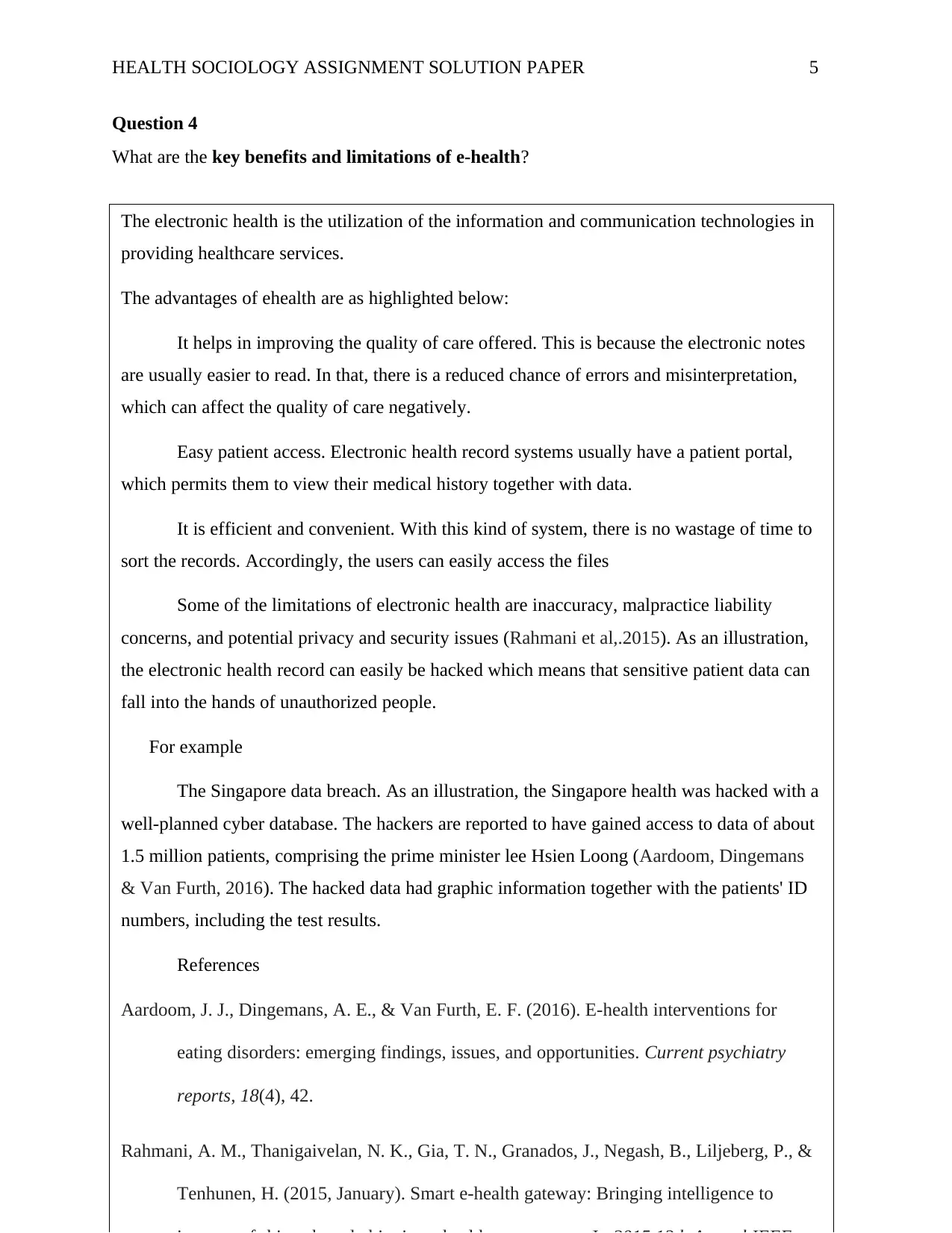
HEALTH SOCIOLOGY ASSIGNMENT SOLUTION PAPER 5
Question 4
What are the key benefits and limitations of e-health?
The electronic health is the utilization of the information and communication technologies in
providing healthcare services.
The advantages of ehealth are as highlighted below:
It helps in improving the quality of care offered. This is because the electronic notes
are usually easier to read. In that, there is a reduced chance of errors and misinterpretation,
which can affect the quality of care negatively.
Easy patient access. Electronic health record systems usually have a patient portal,
which permits them to view their medical history together with data.
It is efficient and convenient. With this kind of system, there is no wastage of time to
sort the records. Accordingly, the users can easily access the files
Some of the limitations of electronic health are inaccuracy, malpractice liability
concerns, and potential privacy and security issues (Rahmani et al,.2015). As an illustration,
the electronic health record can easily be hacked which means that sensitive patient data can
fall into the hands of unauthorized people.
For example
The Singapore data breach. As an illustration, the Singapore health was hacked with a
well-planned cyber database. The hackers are reported to have gained access to data of about
1.5 million patients, comprising the prime minister lee Hsien Loong (Aardoom, Dingemans
& Van Furth, 2016). The hacked data had graphic information together with the patients' ID
numbers, including the test results.
References
Aardoom, J. J., Dingemans, A. E., & Van Furth, E. F. (2016). E-health interventions for
eating disorders: emerging findings, issues, and opportunities. Current psychiatry
reports, 18(4), 42.
Rahmani, A. M., Thanigaivelan, N. K., Gia, T. N., Granados, J., Negash, B., Liljeberg, P., &
Tenhunen, H. (2015, January). Smart e-health gateway: Bringing intelligence to
Question 4
What are the key benefits and limitations of e-health?
The electronic health is the utilization of the information and communication technologies in
providing healthcare services.
The advantages of ehealth are as highlighted below:
It helps in improving the quality of care offered. This is because the electronic notes
are usually easier to read. In that, there is a reduced chance of errors and misinterpretation,
which can affect the quality of care negatively.
Easy patient access. Electronic health record systems usually have a patient portal,
which permits them to view their medical history together with data.
It is efficient and convenient. With this kind of system, there is no wastage of time to
sort the records. Accordingly, the users can easily access the files
Some of the limitations of electronic health are inaccuracy, malpractice liability
concerns, and potential privacy and security issues (Rahmani et al,.2015). As an illustration,
the electronic health record can easily be hacked which means that sensitive patient data can
fall into the hands of unauthorized people.
For example
The Singapore data breach. As an illustration, the Singapore health was hacked with a
well-planned cyber database. The hackers are reported to have gained access to data of about
1.5 million patients, comprising the prime minister lee Hsien Loong (Aardoom, Dingemans
& Van Furth, 2016). The hacked data had graphic information together with the patients' ID
numbers, including the test results.
References
Aardoom, J. J., Dingemans, A. E., & Van Furth, E. F. (2016). E-health interventions for
eating disorders: emerging findings, issues, and opportunities. Current psychiatry
reports, 18(4), 42.
Rahmani, A. M., Thanigaivelan, N. K., Gia, T. N., Granados, J., Negash, B., Liljeberg, P., &
Tenhunen, H. (2015, January). Smart e-health gateway: Bringing intelligence to
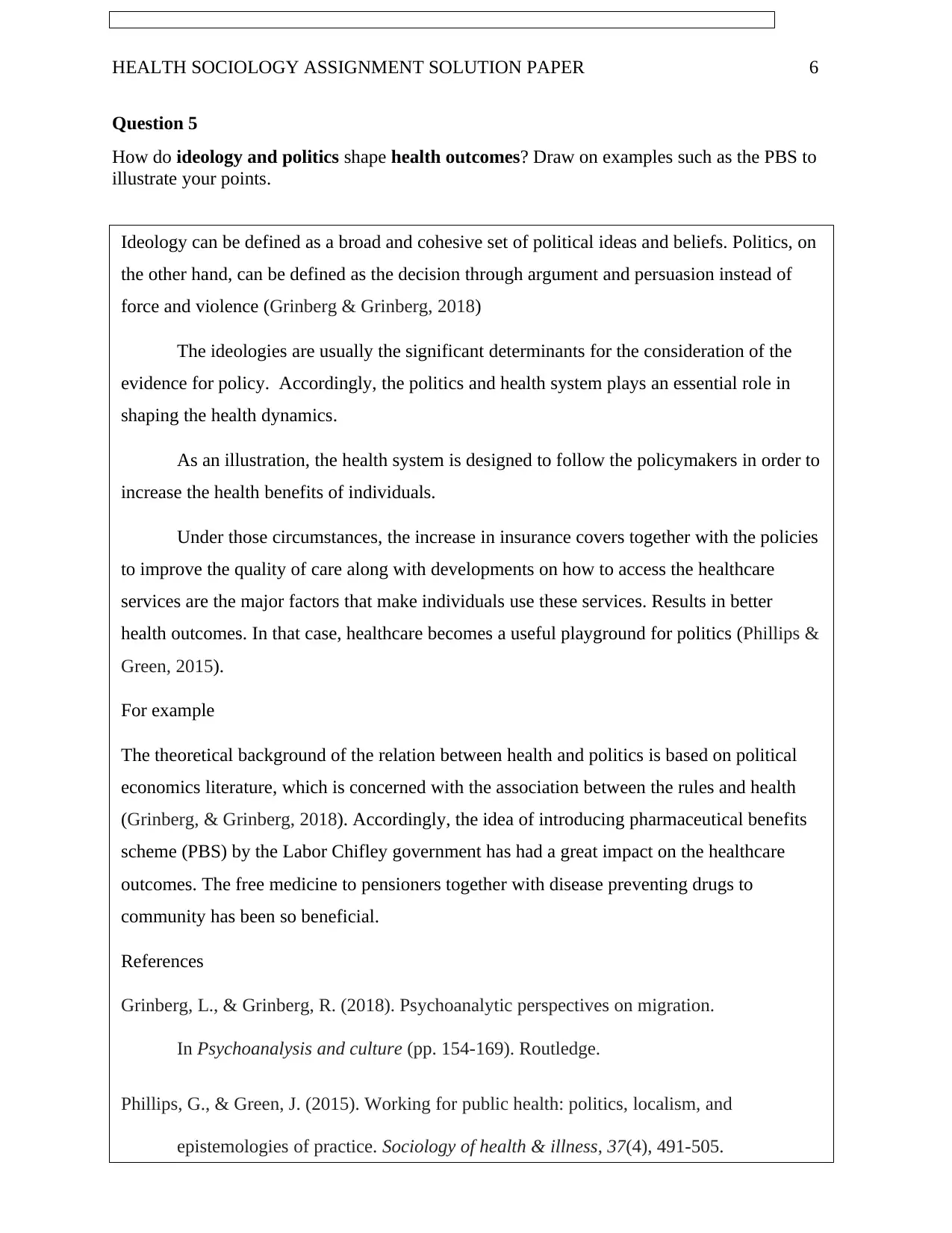
HEALTH SOCIOLOGY ASSIGNMENT SOLUTION PAPER 6
Question 5
How do ideology and politics shape health outcomes? Draw on examples such as the PBS to
illustrate your points.
Ideology can be defined as a broad and cohesive set of political ideas and beliefs. Politics, on
the other hand, can be defined as the decision through argument and persuasion instead of
force and violence (Grinberg & Grinberg, 2018)
The ideologies are usually the significant determinants for the consideration of the
evidence for policy. Accordingly, the politics and health system plays an essential role in
shaping the health dynamics.
As an illustration, the health system is designed to follow the policymakers in order to
increase the health benefits of individuals.
Under those circumstances, the increase in insurance covers together with the policies
to improve the quality of care along with developments on how to access the healthcare
services are the major factors that make individuals use these services. Results in better
health outcomes. In that case, healthcare becomes a useful playground for politics (Phillips &
Green, 2015).
For example
The theoretical background of the relation between health and politics is based on political
economics literature, which is concerned with the association between the rules and health
(Grinberg, & Grinberg, 2018). Accordingly, the idea of introducing pharmaceutical benefits
scheme (PBS) by the Labor Chifley government has had a great impact on the healthcare
outcomes. The free medicine to pensioners together with disease preventing drugs to
community has been so beneficial.
References
Grinberg, L., & Grinberg, R. (2018). Psychoanalytic perspectives on migration.
In Psychoanalysis and culture (pp. 154-169). Routledge.
Phillips, G., & Green, J. (2015). Working for public health: politics, localism, and
epistemologies of practice. Sociology of health & illness, 37(4), 491-505.
Question 5
How do ideology and politics shape health outcomes? Draw on examples such as the PBS to
illustrate your points.
Ideology can be defined as a broad and cohesive set of political ideas and beliefs. Politics, on
the other hand, can be defined as the decision through argument and persuasion instead of
force and violence (Grinberg & Grinberg, 2018)
The ideologies are usually the significant determinants for the consideration of the
evidence for policy. Accordingly, the politics and health system plays an essential role in
shaping the health dynamics.
As an illustration, the health system is designed to follow the policymakers in order to
increase the health benefits of individuals.
Under those circumstances, the increase in insurance covers together with the policies
to improve the quality of care along with developments on how to access the healthcare
services are the major factors that make individuals use these services. Results in better
health outcomes. In that case, healthcare becomes a useful playground for politics (Phillips &
Green, 2015).
For example
The theoretical background of the relation between health and politics is based on political
economics literature, which is concerned with the association between the rules and health
(Grinberg, & Grinberg, 2018). Accordingly, the idea of introducing pharmaceutical benefits
scheme (PBS) by the Labor Chifley government has had a great impact on the healthcare
outcomes. The free medicine to pensioners together with disease preventing drugs to
community has been so beneficial.
References
Grinberg, L., & Grinberg, R. (2018). Psychoanalytic perspectives on migration.
In Psychoanalysis and culture (pp. 154-169). Routledge.
Phillips, G., & Green, J. (2015). Working for public health: politics, localism, and
epistemologies of practice. Sociology of health & illness, 37(4), 491-505.
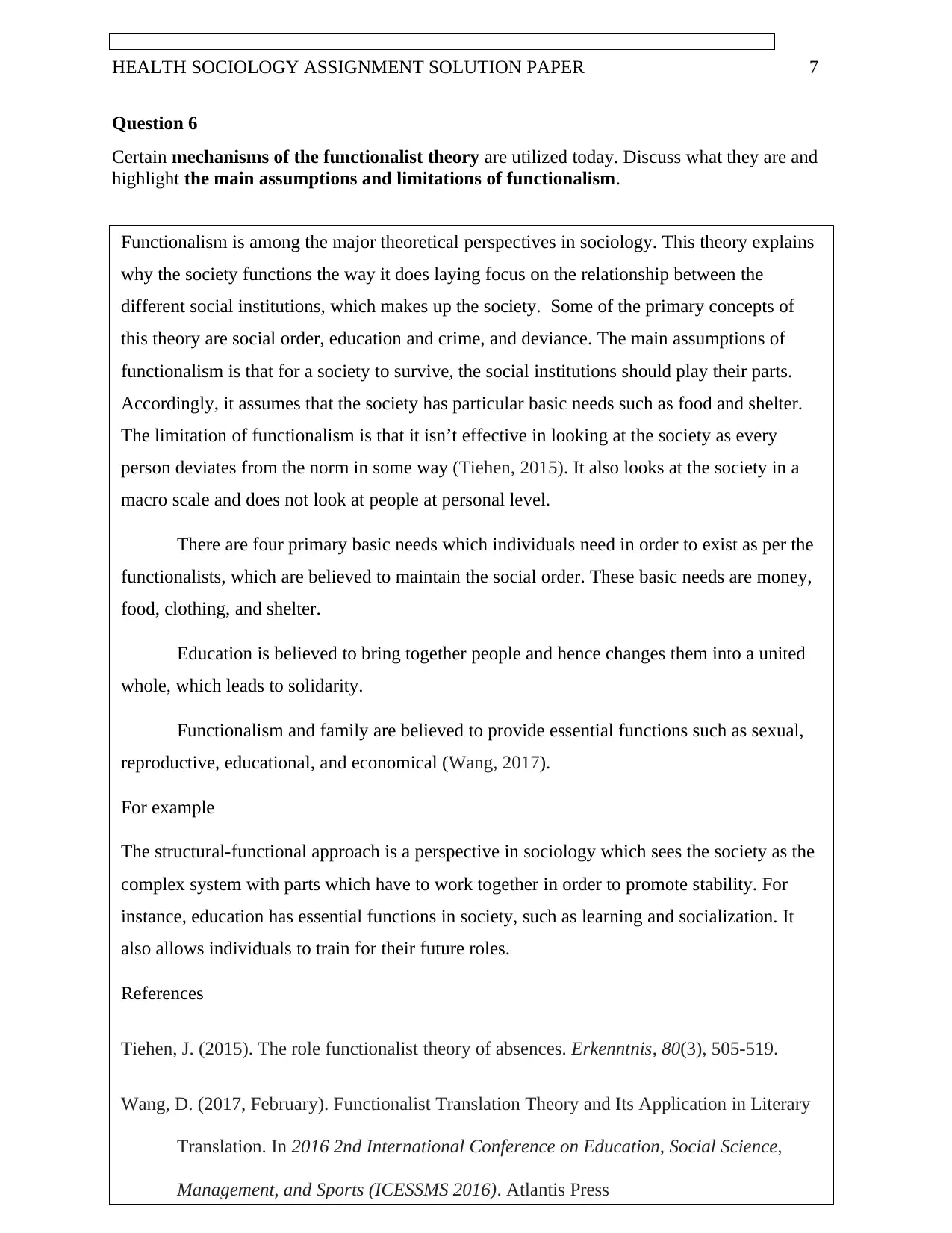
HEALTH SOCIOLOGY ASSIGNMENT SOLUTION PAPER 7
Question 6
Certain mechanisms of the functionalist theory are utilized today. Discuss what they are and
highlight the main assumptions and limitations of functionalism.
Functionalism is among the major theoretical perspectives in sociology. This theory explains
why the society functions the way it does laying focus on the relationship between the
different social institutions, which makes up the society. Some of the primary concepts of
this theory are social order, education and crime, and deviance. The main assumptions of
functionalism is that for a society to survive, the social institutions should play their parts.
Accordingly, it assumes that the society has particular basic needs such as food and shelter.
The limitation of functionalism is that it isn’t effective in looking at the society as every
person deviates from the norm in some way (Tiehen, 2015). It also looks at the society in a
macro scale and does not look at people at personal level.
There are four primary basic needs which individuals need in order to exist as per the
functionalists, which are believed to maintain the social order. These basic needs are money,
food, clothing, and shelter.
Education is believed to bring together people and hence changes them into a united
whole, which leads to solidarity.
Functionalism and family are believed to provide essential functions such as sexual,
reproductive, educational, and economical (Wang, 2017).
For example
The structural-functional approach is a perspective in sociology which sees the society as the
complex system with parts which have to work together in order to promote stability. For
instance, education has essential functions in society, such as learning and socialization. It
also allows individuals to train for their future roles.
References
Tiehen, J. (2015). The role functionalist theory of absences. Erkenntnis, 80(3), 505-519.
Wang, D. (2017, February). Functionalist Translation Theory and Its Application in Literary
Translation. In 2016 2nd International Conference on Education, Social Science,
Management, and Sports (ICESSMS 2016). Atlantis Press
Question 6
Certain mechanisms of the functionalist theory are utilized today. Discuss what they are and
highlight the main assumptions and limitations of functionalism.
Functionalism is among the major theoretical perspectives in sociology. This theory explains
why the society functions the way it does laying focus on the relationship between the
different social institutions, which makes up the society. Some of the primary concepts of
this theory are social order, education and crime, and deviance. The main assumptions of
functionalism is that for a society to survive, the social institutions should play their parts.
Accordingly, it assumes that the society has particular basic needs such as food and shelter.
The limitation of functionalism is that it isn’t effective in looking at the society as every
person deviates from the norm in some way (Tiehen, 2015). It also looks at the society in a
macro scale and does not look at people at personal level.
There are four primary basic needs which individuals need in order to exist as per the
functionalists, which are believed to maintain the social order. These basic needs are money,
food, clothing, and shelter.
Education is believed to bring together people and hence changes them into a united
whole, which leads to solidarity.
Functionalism and family are believed to provide essential functions such as sexual,
reproductive, educational, and economical (Wang, 2017).
For example
The structural-functional approach is a perspective in sociology which sees the society as the
complex system with parts which have to work together in order to promote stability. For
instance, education has essential functions in society, such as learning and socialization. It
also allows individuals to train for their future roles.
References
Tiehen, J. (2015). The role functionalist theory of absences. Erkenntnis, 80(3), 505-519.
Wang, D. (2017, February). Functionalist Translation Theory and Its Application in Literary
Translation. In 2016 2nd International Conference on Education, Social Science,
Management, and Sports (ICESSMS 2016). Atlantis Press
Paraphrase This Document
Need a fresh take? Get an instant paraphrase of this document with our AI Paraphraser
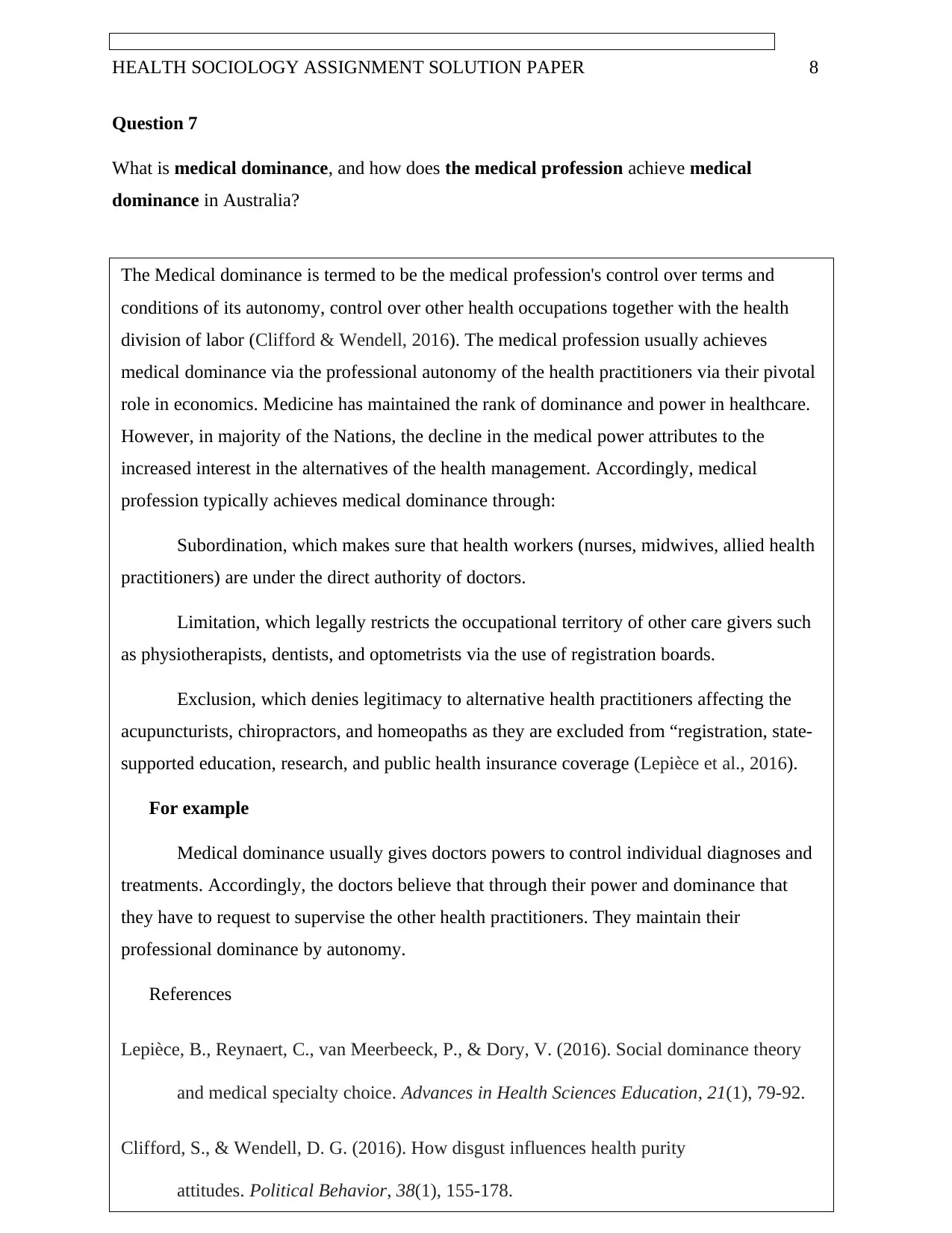
HEALTH SOCIOLOGY ASSIGNMENT SOLUTION PAPER 8
Question 7
What is medical dominance, and how does the medical profession achieve medical
dominance in Australia?
The Medical dominance is termed to be the medical profession's control over terms and
conditions of its autonomy, control over other health occupations together with the health
division of labor (Clifford & Wendell, 2016). The medical profession usually achieves
medical dominance via the professional autonomy of the health practitioners via their pivotal
role in economics. Medicine has maintained the rank of dominance and power in healthcare.
However, in majority of the Nations, the decline in the medical power attributes to the
increased interest in the alternatives of the health management. Accordingly, medical
profession typically achieves medical dominance through:
Subordination, which makes sure that health workers (nurses, midwives, allied health
practitioners) are under the direct authority of doctors.
Limitation, which legally restricts the occupational territory of other care givers such
as physiotherapists, dentists, and optometrists via the use of registration boards.
Exclusion, which denies legitimacy to alternative health practitioners affecting the
acupuncturists, chiropractors, and homeopaths as they are excluded from “registration, state-
supported education, research, and public health insurance coverage (Lepièce et al., 2016).
For example
Medical dominance usually gives doctors powers to control individual diagnoses and
treatments. Accordingly, the doctors believe that through their power and dominance that
they have to request to supervise the other health practitioners. They maintain their
professional dominance by autonomy.
References
Lepièce, B., Reynaert, C., van Meerbeeck, P., & Dory, V. (2016). Social dominance theory
and medical specialty choice. Advances in Health Sciences Education, 21(1), 79-92.
Clifford, S., & Wendell, D. G. (2016). How disgust influences health purity
attitudes. Political Behavior, 38(1), 155-178.
Question 7
What is medical dominance, and how does the medical profession achieve medical
dominance in Australia?
The Medical dominance is termed to be the medical profession's control over terms and
conditions of its autonomy, control over other health occupations together with the health
division of labor (Clifford & Wendell, 2016). The medical profession usually achieves
medical dominance via the professional autonomy of the health practitioners via their pivotal
role in economics. Medicine has maintained the rank of dominance and power in healthcare.
However, in majority of the Nations, the decline in the medical power attributes to the
increased interest in the alternatives of the health management. Accordingly, medical
profession typically achieves medical dominance through:
Subordination, which makes sure that health workers (nurses, midwives, allied health
practitioners) are under the direct authority of doctors.
Limitation, which legally restricts the occupational territory of other care givers such
as physiotherapists, dentists, and optometrists via the use of registration boards.
Exclusion, which denies legitimacy to alternative health practitioners affecting the
acupuncturists, chiropractors, and homeopaths as they are excluded from “registration, state-
supported education, research, and public health insurance coverage (Lepièce et al., 2016).
For example
Medical dominance usually gives doctors powers to control individual diagnoses and
treatments. Accordingly, the doctors believe that through their power and dominance that
they have to request to supervise the other health practitioners. They maintain their
professional dominance by autonomy.
References
Lepièce, B., Reynaert, C., van Meerbeeck, P., & Dory, V. (2016). Social dominance theory
and medical specialty choice. Advances in Health Sciences Education, 21(1), 79-92.
Clifford, S., & Wendell, D. G. (2016). How disgust influences health purity
attitudes. Political Behavior, 38(1), 155-178.
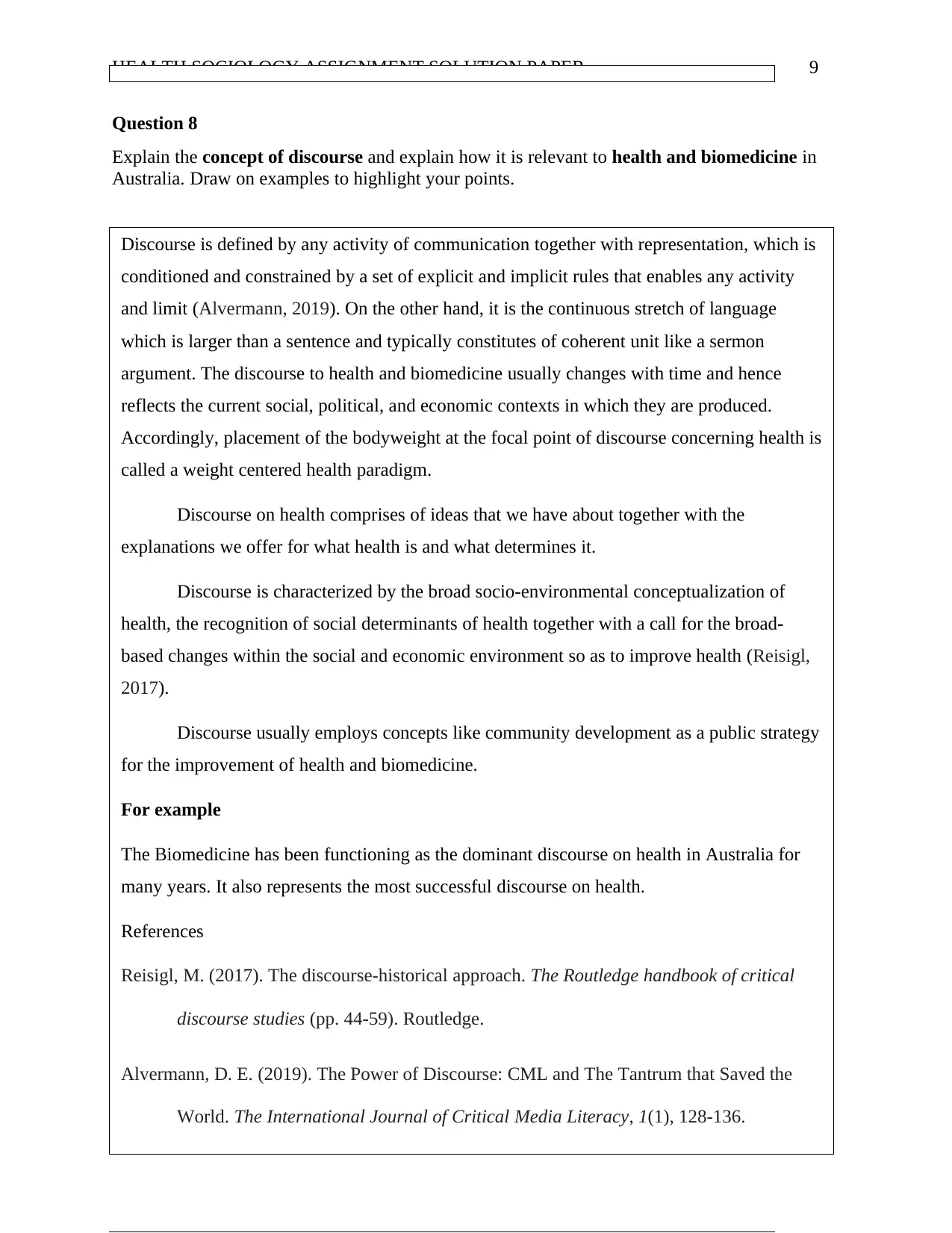
HEALTH SOCIOLOGY ASSIGNMENT SOLUTION PAPER 9
Question 8
Explain the concept of discourse and explain how it is relevant to health and biomedicine in
Australia. Draw on examples to highlight your points.
Discourse is defined by any activity of communication together with representation, which is
conditioned and constrained by a set of explicit and implicit rules that enables any activity
and limit (Alvermann, 2019). On the other hand, it is the continuous stretch of language
which is larger than a sentence and typically constitutes of coherent unit like a sermon
argument. The discourse to health and biomedicine usually changes with time and hence
reflects the current social, political, and economic contexts in which they are produced.
Accordingly, placement of the bodyweight at the focal point of discourse concerning health is
called a weight centered health paradigm.
Discourse on health comprises of ideas that we have about together with the
explanations we offer for what health is and what determines it.
Discourse is characterized by the broad socio-environmental conceptualization of
health, the recognition of social determinants of health together with a call for the broad-
based changes within the social and economic environment so as to improve health (Reisigl,
2017).
Discourse usually employs concepts like community development as a public strategy
for the improvement of health and biomedicine.
For example
The Biomedicine has been functioning as the dominant discourse on health in Australia for
many years. It also represents the most successful discourse on health.
References
Reisigl, M. (2017). The discourse-historical approach. The Routledge handbook of critical
discourse studies (pp. 44-59). Routledge.
Alvermann, D. E. (2019). The Power of Discourse: CML and The Tantrum that Saved the
World. The International Journal of Critical Media Literacy, 1(1), 128-136.
Question 8
Explain the concept of discourse and explain how it is relevant to health and biomedicine in
Australia. Draw on examples to highlight your points.
Discourse is defined by any activity of communication together with representation, which is
conditioned and constrained by a set of explicit and implicit rules that enables any activity
and limit (Alvermann, 2019). On the other hand, it is the continuous stretch of language
which is larger than a sentence and typically constitutes of coherent unit like a sermon
argument. The discourse to health and biomedicine usually changes with time and hence
reflects the current social, political, and economic contexts in which they are produced.
Accordingly, placement of the bodyweight at the focal point of discourse concerning health is
called a weight centered health paradigm.
Discourse on health comprises of ideas that we have about together with the
explanations we offer for what health is and what determines it.
Discourse is characterized by the broad socio-environmental conceptualization of
health, the recognition of social determinants of health together with a call for the broad-
based changes within the social and economic environment so as to improve health (Reisigl,
2017).
Discourse usually employs concepts like community development as a public strategy
for the improvement of health and biomedicine.
For example
The Biomedicine has been functioning as the dominant discourse on health in Australia for
many years. It also represents the most successful discourse on health.
References
Reisigl, M. (2017). The discourse-historical approach. The Routledge handbook of critical
discourse studies (pp. 44-59). Routledge.
Alvermann, D. E. (2019). The Power of Discourse: CML and The Tantrum that Saved the
World. The International Journal of Critical Media Literacy, 1(1), 128-136.
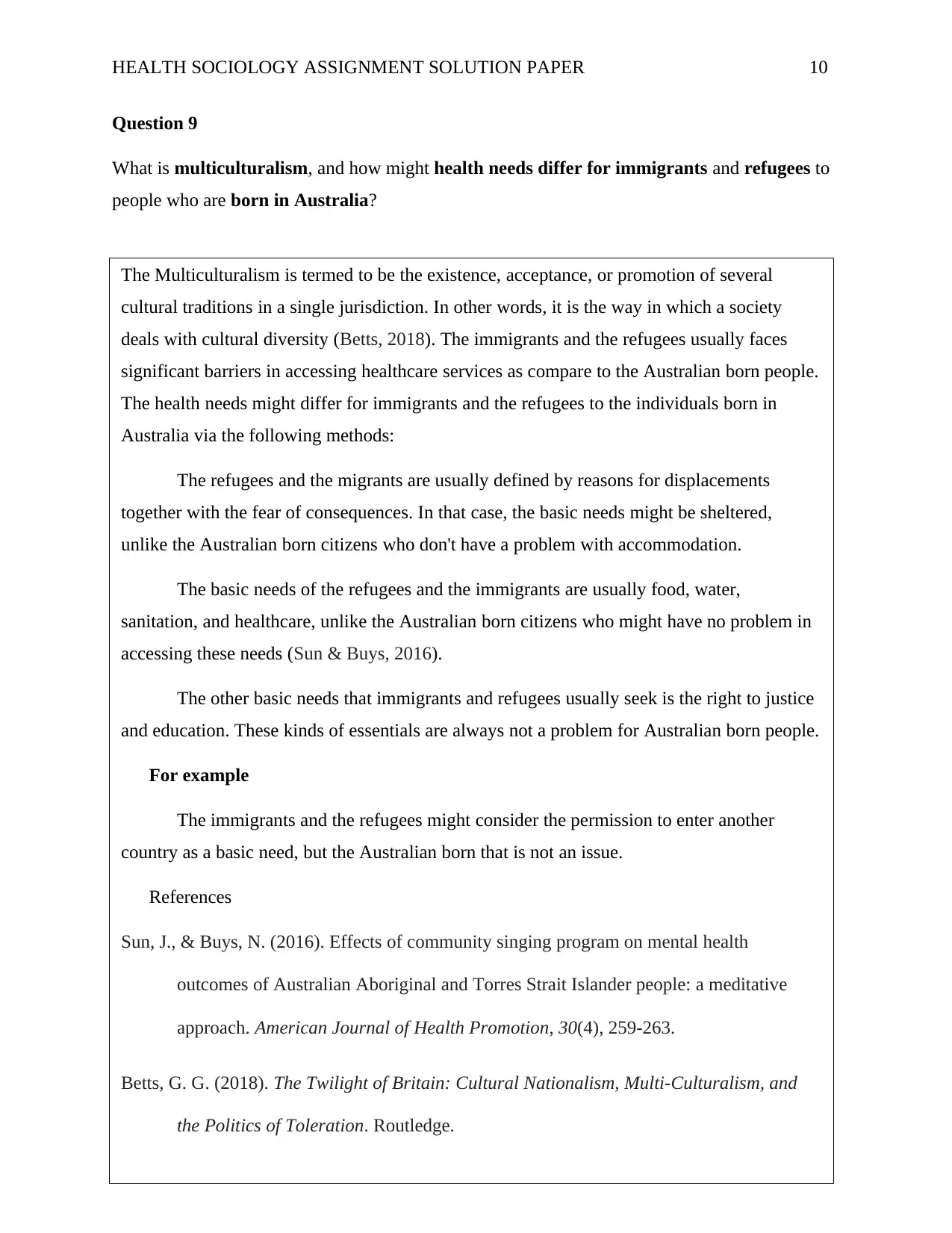
HEALTH SOCIOLOGY ASSIGNMENT SOLUTION PAPER 10
Question 9
What is multiculturalism, and how might health needs differ for immigrants and refugees to
people who are born in Australia?
The Multiculturalism is termed to be the existence, acceptance, or promotion of several
cultural traditions in a single jurisdiction. In other words, it is the way in which a society
deals with cultural diversity (Betts, 2018). The immigrants and the refugees usually faces
significant barriers in accessing healthcare services as compare to the Australian born people.
The health needs might differ for immigrants and the refugees to the individuals born in
Australia via the following methods:
The refugees and the migrants are usually defined by reasons for displacements
together with the fear of consequences. In that case, the basic needs might be sheltered,
unlike the Australian born citizens who don't have a problem with accommodation.
The basic needs of the refugees and the immigrants are usually food, water,
sanitation, and healthcare, unlike the Australian born citizens who might have no problem in
accessing these needs (Sun & Buys, 2016).
The other basic needs that immigrants and refugees usually seek is the right to justice
and education. These kinds of essentials are always not a problem for Australian born people.
For example
The immigrants and the refugees might consider the permission to enter another
country as a basic need, but the Australian born that is not an issue.
References
Sun, J., & Buys, N. (2016). Effects of community singing program on mental health
outcomes of Australian Aboriginal and Torres Strait Islander people: a meditative
approach. American Journal of Health Promotion, 30(4), 259-263.
Betts, G. G. (2018). The Twilight of Britain: Cultural Nationalism, Multi-Culturalism, and
the Politics of Toleration. Routledge.
Question 9
What is multiculturalism, and how might health needs differ for immigrants and refugees to
people who are born in Australia?
The Multiculturalism is termed to be the existence, acceptance, or promotion of several
cultural traditions in a single jurisdiction. In other words, it is the way in which a society
deals with cultural diversity (Betts, 2018). The immigrants and the refugees usually faces
significant barriers in accessing healthcare services as compare to the Australian born people.
The health needs might differ for immigrants and the refugees to the individuals born in
Australia via the following methods:
The refugees and the migrants are usually defined by reasons for displacements
together with the fear of consequences. In that case, the basic needs might be sheltered,
unlike the Australian born citizens who don't have a problem with accommodation.
The basic needs of the refugees and the immigrants are usually food, water,
sanitation, and healthcare, unlike the Australian born citizens who might have no problem in
accessing these needs (Sun & Buys, 2016).
The other basic needs that immigrants and refugees usually seek is the right to justice
and education. These kinds of essentials are always not a problem for Australian born people.
For example
The immigrants and the refugees might consider the permission to enter another
country as a basic need, but the Australian born that is not an issue.
References
Sun, J., & Buys, N. (2016). Effects of community singing program on mental health
outcomes of Australian Aboriginal and Torres Strait Islander people: a meditative
approach. American Journal of Health Promotion, 30(4), 259-263.
Betts, G. G. (2018). The Twilight of Britain: Cultural Nationalism, Multi-Culturalism, and
the Politics of Toleration. Routledge.
Secure Best Marks with AI Grader
Need help grading? Try our AI Grader for instant feedback on your assignments.
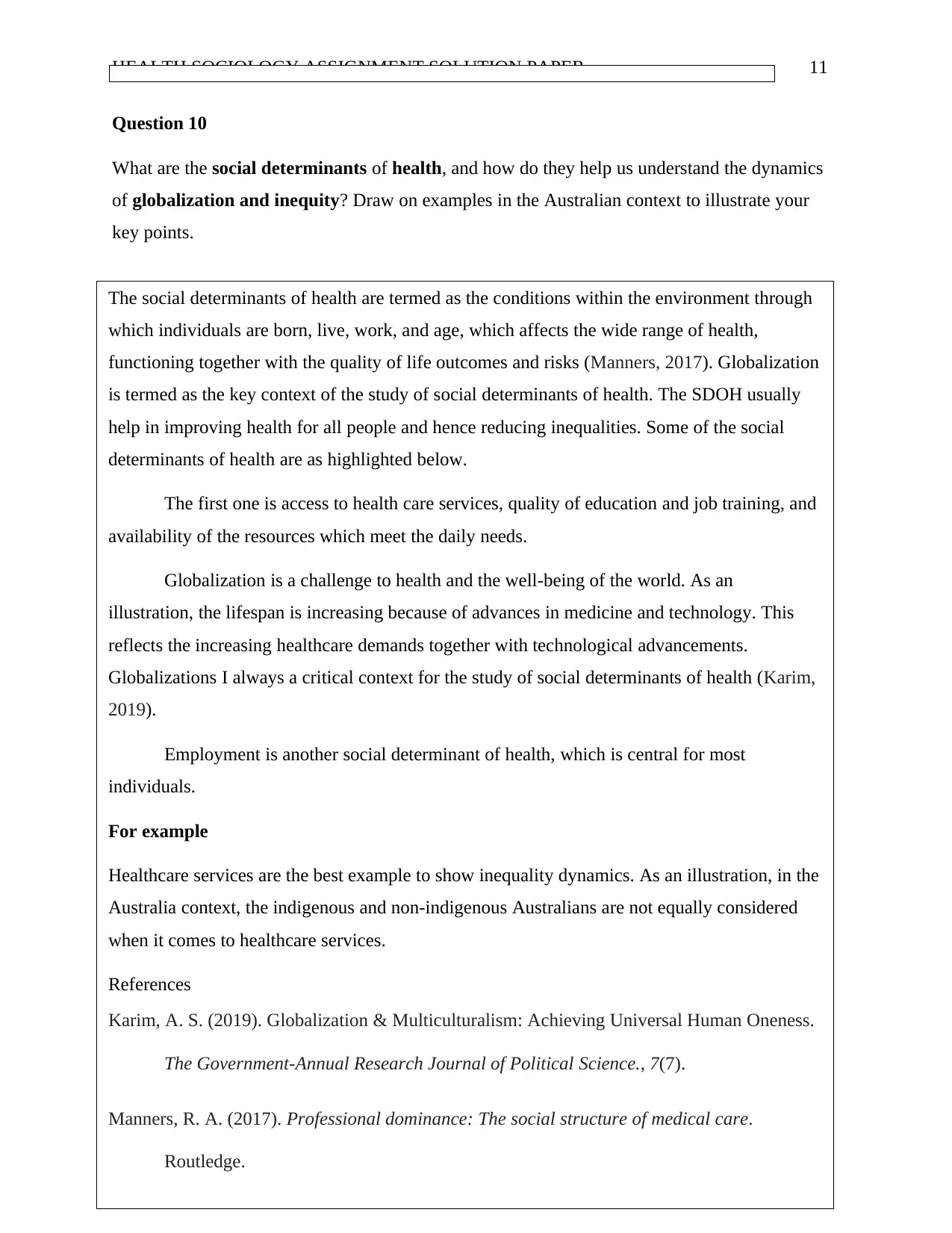
HEALTH SOCIOLOGY ASSIGNMENT SOLUTION PAPER 11
Question 10
What are the social determinants of health, and how do they help us understand the dynamics
of globalization and inequity? Draw on examples in the Australian context to illustrate your
key points.
The social determinants of health are termed as the conditions within the environment through
which individuals are born, live, work, and age, which affects the wide range of health,
functioning together with the quality of life outcomes and risks (Manners, 2017). Globalization
is termed as the key context of the study of social determinants of health. The SDOH usually
help in improving health for all people and hence reducing inequalities. Some of the social
determinants of health are as highlighted below.
The first one is access to health care services, quality of education and job training, and
availability of the resources which meet the daily needs.
Globalization is a challenge to health and the well-being of the world. As an
illustration, the lifespan is increasing because of advances in medicine and technology. This
reflects the increasing healthcare demands together with technological advancements.
Globalizations I always a critical context for the study of social determinants of health (Karim,
2019).
Employment is another social determinant of health, which is central for most
individuals.
For example
Healthcare services are the best example to show inequality dynamics. As an illustration, in the
Australia context, the indigenous and non-indigenous Australians are not equally considered
when it comes to healthcare services.
References
Karim, A. S. (2019). Globalization & Multiculturalism: Achieving Universal Human Oneness.
The Government-Annual Research Journal of Political Science., 7(7).
Manners, R. A. (2017). Professional dominance: The social structure of medical care.
Routledge.
Question 10
What are the social determinants of health, and how do they help us understand the dynamics
of globalization and inequity? Draw on examples in the Australian context to illustrate your
key points.
The social determinants of health are termed as the conditions within the environment through
which individuals are born, live, work, and age, which affects the wide range of health,
functioning together with the quality of life outcomes and risks (Manners, 2017). Globalization
is termed as the key context of the study of social determinants of health. The SDOH usually
help in improving health for all people and hence reducing inequalities. Some of the social
determinants of health are as highlighted below.
The first one is access to health care services, quality of education and job training, and
availability of the resources which meet the daily needs.
Globalization is a challenge to health and the well-being of the world. As an
illustration, the lifespan is increasing because of advances in medicine and technology. This
reflects the increasing healthcare demands together with technological advancements.
Globalizations I always a critical context for the study of social determinants of health (Karim,
2019).
Employment is another social determinant of health, which is central for most
individuals.
For example
Healthcare services are the best example to show inequality dynamics. As an illustration, in the
Australia context, the indigenous and non-indigenous Australians are not equally considered
when it comes to healthcare services.
References
Karim, A. S. (2019). Globalization & Multiculturalism: Achieving Universal Human Oneness.
The Government-Annual Research Journal of Political Science., 7(7).
Manners, R. A. (2017). Professional dominance: The social structure of medical care.
Routledge.
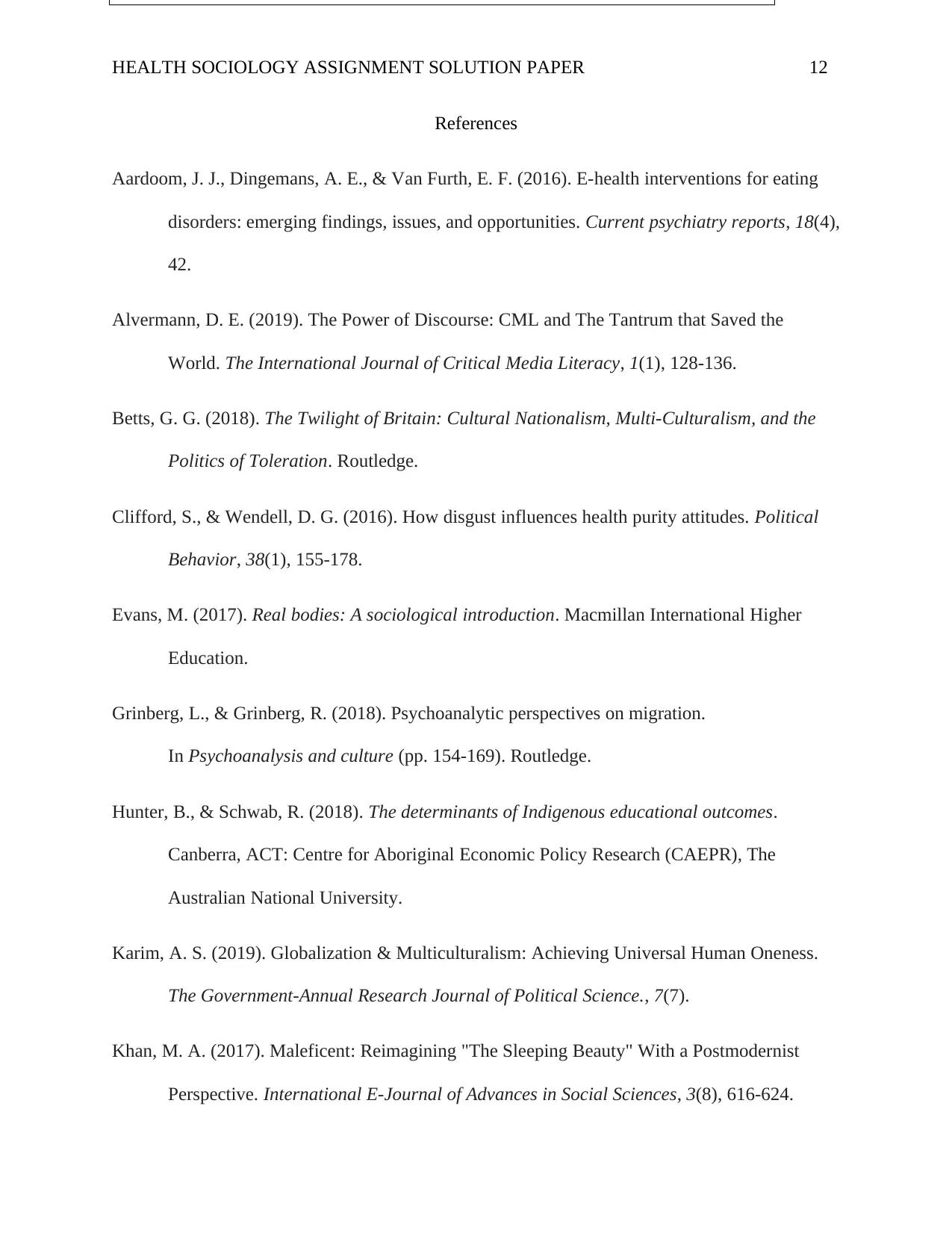
HEALTH SOCIOLOGY ASSIGNMENT SOLUTION PAPER 12
References
Aardoom, J. J., Dingemans, A. E., & Van Furth, E. F. (2016). E-health interventions for eating
disorders: emerging findings, issues, and opportunities. Current psychiatry reports, 18(4),
42.
Alvermann, D. E. (2019). The Power of Discourse: CML and The Tantrum that Saved the
World. The International Journal of Critical Media Literacy, 1(1), 128-136.
Betts, G. G. (2018). The Twilight of Britain: Cultural Nationalism, Multi-Culturalism, and the
Politics of Toleration. Routledge.
Clifford, S., & Wendell, D. G. (2016). How disgust influences health purity attitudes. Political
Behavior, 38(1), 155-178.
Evans, M. (2017). Real bodies: A sociological introduction. Macmillan International Higher
Education.
Grinberg, L., & Grinberg, R. (2018). Psychoanalytic perspectives on migration.
In Psychoanalysis and culture (pp. 154-169). Routledge.
Hunter, B., & Schwab, R. (2018). The determinants of Indigenous educational outcomes.
Canberra, ACT: Centre for Aboriginal Economic Policy Research (CAEPR), The
Australian National University.
Karim, A. S. (2019). Globalization & Multiculturalism: Achieving Universal Human Oneness.
The Government-Annual Research Journal of Political Science., 7(7).
Khan, M. A. (2017). Maleficent: Reimagining "The Sleeping Beauty" With a Postmodernist
Perspective. International E-Journal of Advances in Social Sciences, 3(8), 616-624.
References
Aardoom, J. J., Dingemans, A. E., & Van Furth, E. F. (2016). E-health interventions for eating
disorders: emerging findings, issues, and opportunities. Current psychiatry reports, 18(4),
42.
Alvermann, D. E. (2019). The Power of Discourse: CML and The Tantrum that Saved the
World. The International Journal of Critical Media Literacy, 1(1), 128-136.
Betts, G. G. (2018). The Twilight of Britain: Cultural Nationalism, Multi-Culturalism, and the
Politics of Toleration. Routledge.
Clifford, S., & Wendell, D. G. (2016). How disgust influences health purity attitudes. Political
Behavior, 38(1), 155-178.
Evans, M. (2017). Real bodies: A sociological introduction. Macmillan International Higher
Education.
Grinberg, L., & Grinberg, R. (2018). Psychoanalytic perspectives on migration.
In Psychoanalysis and culture (pp. 154-169). Routledge.
Hunter, B., & Schwab, R. (2018). The determinants of Indigenous educational outcomes.
Canberra, ACT: Centre for Aboriginal Economic Policy Research (CAEPR), The
Australian National University.
Karim, A. S. (2019). Globalization & Multiculturalism: Achieving Universal Human Oneness.
The Government-Annual Research Journal of Political Science., 7(7).
Khan, M. A. (2017). Maleficent: Reimagining "The Sleeping Beauty" With a Postmodernist
Perspective. International E-Journal of Advances in Social Sciences, 3(8), 616-624.
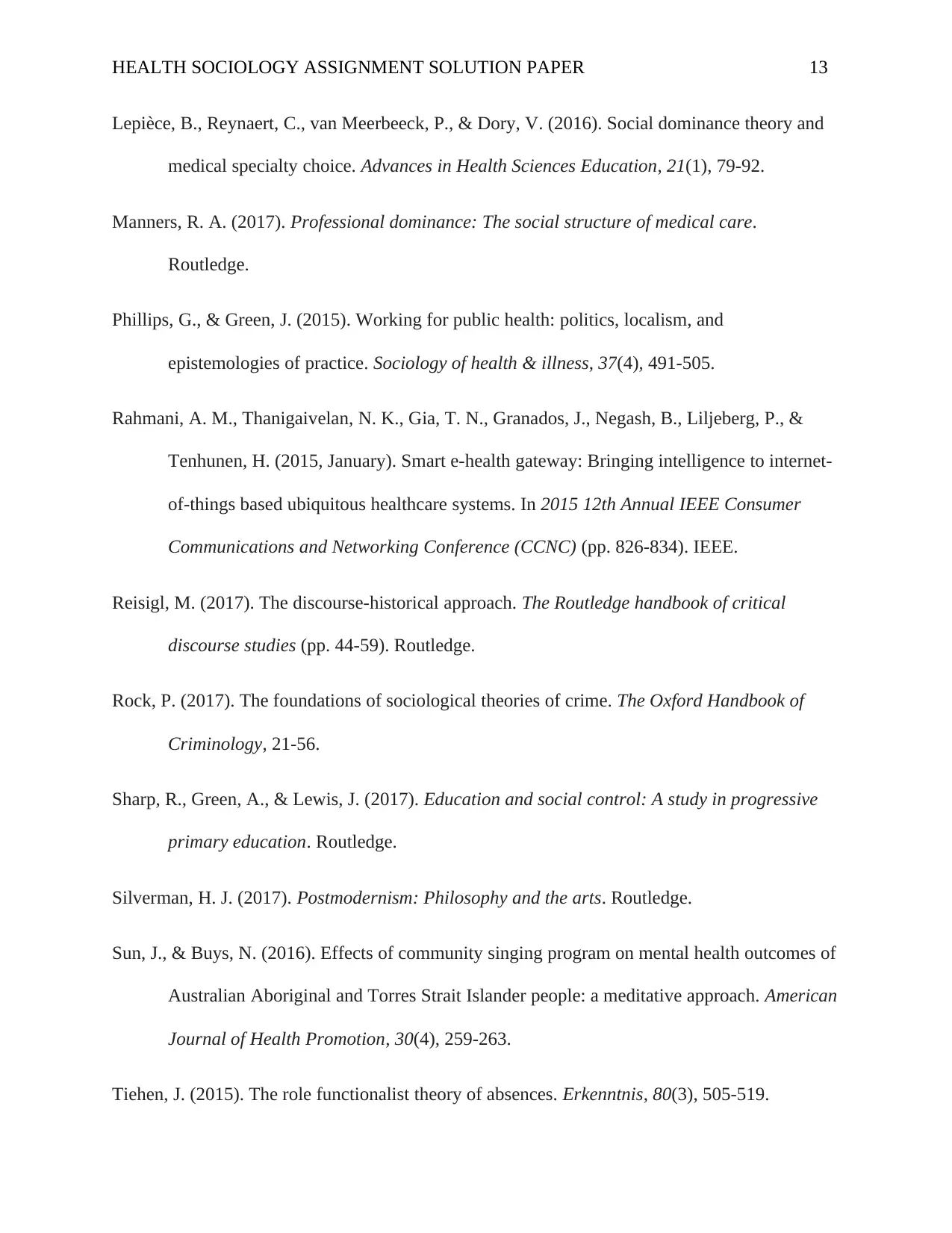
HEALTH SOCIOLOGY ASSIGNMENT SOLUTION PAPER 13
Lepièce, B., Reynaert, C., van Meerbeeck, P., & Dory, V. (2016). Social dominance theory and
medical specialty choice. Advances in Health Sciences Education, 21(1), 79-92.
Manners, R. A. (2017). Professional dominance: The social structure of medical care.
Routledge.
Phillips, G., & Green, J. (2015). Working for public health: politics, localism, and
epistemologies of practice. Sociology of health & illness, 37(4), 491-505.
Rahmani, A. M., Thanigaivelan, N. K., Gia, T. N., Granados, J., Negash, B., Liljeberg, P., &
Tenhunen, H. (2015, January). Smart e-health gateway: Bringing intelligence to internet-
of-things based ubiquitous healthcare systems. In 2015 12th Annual IEEE Consumer
Communications and Networking Conference (CCNC) (pp. 826-834). IEEE.
Reisigl, M. (2017). The discourse-historical approach. The Routledge handbook of critical
discourse studies (pp. 44-59). Routledge.
Rock, P. (2017). The foundations of sociological theories of crime. The Oxford Handbook of
Criminology, 21-56.
Sharp, R., Green, A., & Lewis, J. (2017). Education and social control: A study in progressive
primary education. Routledge.
Silverman, H. J. (2017). Postmodernism: Philosophy and the arts. Routledge.
Sun, J., & Buys, N. (2016). Effects of community singing program on mental health outcomes of
Australian Aboriginal and Torres Strait Islander people: a meditative approach. American
Journal of Health Promotion, 30(4), 259-263.
Tiehen, J. (2015). The role functionalist theory of absences. Erkenntnis, 80(3), 505-519.
Lepièce, B., Reynaert, C., van Meerbeeck, P., & Dory, V. (2016). Social dominance theory and
medical specialty choice. Advances in Health Sciences Education, 21(1), 79-92.
Manners, R. A. (2017). Professional dominance: The social structure of medical care.
Routledge.
Phillips, G., & Green, J. (2015). Working for public health: politics, localism, and
epistemologies of practice. Sociology of health & illness, 37(4), 491-505.
Rahmani, A. M., Thanigaivelan, N. K., Gia, T. N., Granados, J., Negash, B., Liljeberg, P., &
Tenhunen, H. (2015, January). Smart e-health gateway: Bringing intelligence to internet-
of-things based ubiquitous healthcare systems. In 2015 12th Annual IEEE Consumer
Communications and Networking Conference (CCNC) (pp. 826-834). IEEE.
Reisigl, M. (2017). The discourse-historical approach. The Routledge handbook of critical
discourse studies (pp. 44-59). Routledge.
Rock, P. (2017). The foundations of sociological theories of crime. The Oxford Handbook of
Criminology, 21-56.
Sharp, R., Green, A., & Lewis, J. (2017). Education and social control: A study in progressive
primary education. Routledge.
Silverman, H. J. (2017). Postmodernism: Philosophy and the arts. Routledge.
Sun, J., & Buys, N. (2016). Effects of community singing program on mental health outcomes of
Australian Aboriginal and Torres Strait Islander people: a meditative approach. American
Journal of Health Promotion, 30(4), 259-263.
Tiehen, J. (2015). The role functionalist theory of absences. Erkenntnis, 80(3), 505-519.
Paraphrase This Document
Need a fresh take? Get an instant paraphrase of this document with our AI Paraphraser
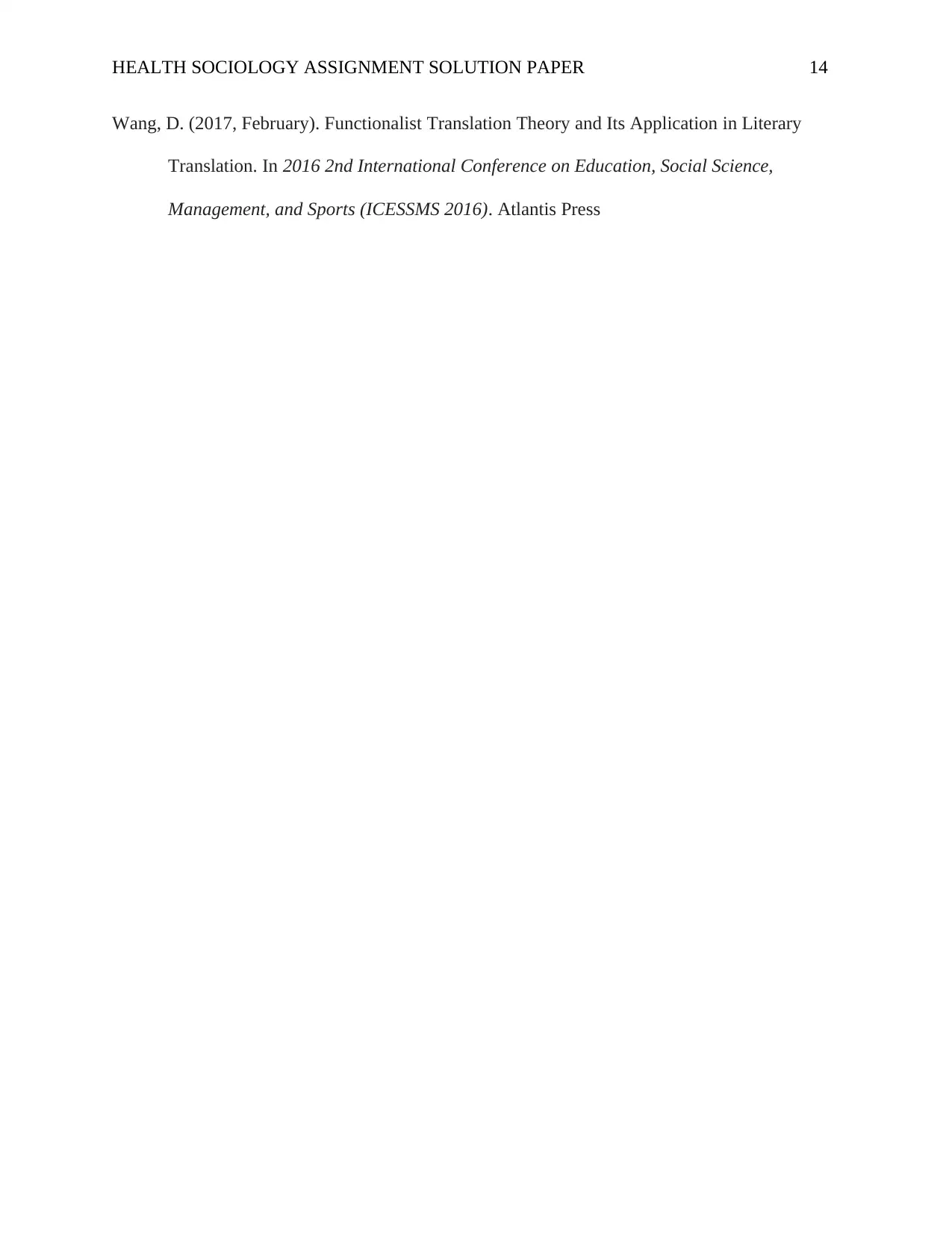
HEALTH SOCIOLOGY ASSIGNMENT SOLUTION PAPER 14
Wang, D. (2017, February). Functionalist Translation Theory and Its Application in Literary
Translation. In 2016 2nd International Conference on Education, Social Science,
Management, and Sports (ICESSMS 2016). Atlantis Press
Wang, D. (2017, February). Functionalist Translation Theory and Its Application in Literary
Translation. In 2016 2nd International Conference on Education, Social Science,
Management, and Sports (ICESSMS 2016). Atlantis Press
1 out of 14
Your All-in-One AI-Powered Toolkit for Academic Success.
+13062052269
info@desklib.com
Available 24*7 on WhatsApp / Email
![[object Object]](/_next/static/media/star-bottom.7253800d.svg)
Unlock your academic potential
© 2024 | Zucol Services PVT LTD | All rights reserved.